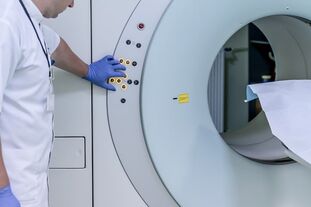Most people experience back problems from time to time and experience pain in the lower back, neck, or middle back. In fact, back pain is the most common physical complaint among the adult population and a leading cause of temporary disability. The back pain can be mild or severe, the pain can be short-term or chronic.
Back pain includes: muscle and tendon pain, disc herniation, fracture, or other back problems. Most often, the reasons go back a long time. The most common back pain is caused by diseases of the spine.

The structure of the spine is designed for extreme loads. The structure of the spine is stable enough for a person to walk (stand) and flexible enough to perform torso movements.
A healthy spine has elongated S-shaped, natural curves in the lumbar, chest, and cervical spine when viewed from the side. The spine is the main supporting part of the trunk. In addition, the bone structure of the spine protects the spinal cord and the roots of the spinal cord, thus ensuring normal innervation of organs and tissues.
Between the vertebrae 24 are vertebral discs that perform a damping function.
Causes
Back pain refers to problems that a person usually causes to himself. Back problems and back pain are most often caused by bad habits that have accumulated over a long period of time. These bad habits are:
- Poor posture
- Overvoltage while working
- Improper posture at desk or while driving
- Repeated stretching or lengthening of the spine or abnormal sharp weight lifting.
Habit results rarely appear immediately, but their negative effects accumulate over time. One of the most common back pain is pain associated with tension in the muscles surrounding the spine. The most common pain is back pain, muscles in the lumbar spine and cervical spine. If muscle tension involves lifting heavy objects, the pain can be excruciating.
Sometimes back pain occurs for no apparent reason. In such cases, they talk about non-specific back pain. Such pain can develop due to weakened muscles that cannot cope with everyday stress, such as walking, bending and stretching. In addition, such non-specific pain can be triggered by poor sleep, general fatigue, or exposure to stressful situations.
In myofascial pain syndrome, chronic pain is caused by localized muscle tension. Sometimes this localized muscle tension is due to stress or other emotional problems.
Pregnancyis often the cause of the disease, and it is due to both hormonal changes in a woman’s body and weight gain, as well as excessive stress on the spine and legs.
Contact sports injuries, accidents, and falls can also cause back problems, from less muscle strain to serious injuries such as the spine and spinal cord.
It is important to understand that back pain is a symptom of the disease and not a diagnosis. The medical conditions that cause back pain are:
Mechanical Problems: Mechanical problems are related to spinal movements or feelings that a person experiences when performing certain movements. The most common mechanical cause is degeneration of the intervertebral discs (osteochondrosis), when evolutionary changes occur in the intervertebral discs and deterioration of the damping functions of the discs, leading to the appearance of pain. Another cause of back pain is degenerative changes in the joints of the spine (spondyloarthrosis). Other mechanical causes include muscle cramps, muscle tension, and disc herniation.
Injuries: Spinal injuries such as sprains and fractures can cause both acute and chronic pain. Sprains, rupture of the ligaments holding the spine may result from twisting or incorrect lifting of the torso. Vertebral fractures are often the result of osteoporosis, a disorder in which bone density is impaired. Less commonly, back pain can be caused by more serious injuries resulting from accidents and falls.
Acquired conditions and diseases. Many diseases can cause or contribute to pain. These include scoliosis, kyphosis, kyphoscoliosis, which usually have no pain until the Middle Ages. Different types of arthritis (osteoarthritis, rheumatoid arthritis, ankylosing spondylitis), narrowing of the spinal canal that affects the nerve roots of the spinal cord. Diseases such as osteoporosis are painless on their own, but can lead to vertebral fractures that manifest as severe pain. Other causes of back pain include pregnancy, kidney infections or urolithiasis, endometriosis, fibromyalgia, characterized by chronic fatigue and diffuse muscle pain.
Infections and tumors. Although infections are not common causes of disease, infections can still cause pain. If the bone tissue is affected, we speak of osteomyelitis, if the infection affects the intervertebral discs, we speak of discitis. Tumors are also relatively rare in pain. Sometimes spinal tumors are primary, but most often the tumors are metastatic and the primary focus is on the other part of the body.
While the causes of back pain are usually physical, it is important to understand that emotional stress can play a role in both the intensity and duration of pain. In addition, stress and emotional state can affect skeletal muscle tone. So in the presence of depression and anxiety, back pain can be more intense. In addition, insomnia or lack of sleep can contribute to or exacerbate pain.
Back pain is only a symptom and may be reflected. Many diseases of the peritoneum and pelvic organs can cause spinal pain (appendicitis, aneurysm, kidney disease, bladder disease, infections, and pelvic inflammatory disease).
Risk Factors
- Age over 40
- Male gender
- Family History
- Previous Injuries
- Pregnancy
- Surgical operations on the spine in the past
- Congenital disorders of the spine.
- Lack of regular exercise
- A job or activity that involves prolonged weight lifting.
- Smoking. People who smoke more often than non-smokers experience back pain.
- Overweight. Being overweight, especially those who have fat around their waist, can put more strain on their backs and tend to have weak muscles and limited movement.
- Bad posture. Postural disorder leads to disruption of the distribution of load vectors, muscle tension, muscle cramps, and pain.
- Stress. Stress and other emotional factors are thought to play an important role in back pain, especially chronic pain. Many unconsciously stretch their back muscles when stressed.
- Condition after long depression.
- Long-term use of drugs that weaken bone tissue (such as steroids).
- Lung diseases leading to chronic cough.
Symptoms
Most people have experienced back pain in their lifetime. There are many causes of back pain, some of which are man-made. Other causes: accidents, muscle spasms, sports injuries and various diseases. Although the causes may be different, they are most often marked with the same symptoms.
- Prolonged pain or stiffness in any part of the spine, from the neck to the tail
- Acute, localized pain in the neck, upper back, or lower back - especially after lifting heavy objects or strenuous activities. (Pain on top can be a sign of a heart attack or other life-threatening condition. )
- Chronic pain in the middle or lower part, especially after prolonged sitting or standing.
- Low back pain that radiates to the bottom of the foot.
- Unable to stand up straight.
But there are symptoms that require a doctor
- Feeling numbness, tingling, or weakness in the arms or legs, as this may indicate damage to the spinal cord.
- Lower back pain radiates toward the foot, which may be evidence of root compression (radiculitis).
- Pain increases when you cough or bend forward, which may be a sign of a disc herniation.
- Pain during urination is accompanied by fever and a burning sensation, which may be a sign of a urinary tract infection.
- Intestinal or bladder problems
- The history of cancer
- Weight Loss
- Long-term steroid use
- History of Trauma
- Increased nausea even after rest.
- Pain lasting more than a month
- Night pain
- Treatment has no effect
- History of drug use
Diagnostics

Due to the fact that back pain can be caused by a variety of conditions, it is first important for the doctor to carefully collect the medical history and symptoms. Both the localization of pain and the intensity and presence of radiation are important. Physical examination involves careful examination of the neurological condition (reflex activity, muscle strength, sensitivity, etc. ). If you suspect diseases of the pelvic organs, your doctor may prescribe a gynecologist or urologist.
Instrumental research methods
Radiography is generally of little importance in diagnosing spinal pain, especially when there are no significant symptoms. X-rays are indicated for the treatment of acute, significant injuries or minor injuries in patients over 50 years of age, in patients with osteoporosis or in long-term steroid use.
MRI is the most informative diagnostic method that allows high-quality imaging of both bone and soft tissues and allows the diagnosis of both degenerative changes and tumors or infections.
CT may be recommended to show changes in bone tissue more clearly.
EMG and ENMG allow the determination of nerve fiber and muscle conduction and are commonly used to diagnose chronic back pain.
Ultrasound of the abdominal organs or the pelvis, kidneys is necessary to differentiate the source of pain.
Laboratory research methods are also used in the differential diagnosis of inflammatory diseases or infections.
Management
There are no universal treatments for back pain. The treatment of back pain in each case depends on both the onset of the manifestations of pain and the individual characteristics of the person, as people's perceptions vary significantly.
Medical treatment involves the use of a variety of medications, both conventional painkillers or NSAIDs, and muscle relaxants or antibiotics to treat infections. With chronic pain syndrome, antidepressants, sedatives, or neuroleptics may be used.

Non-drug treatments such as physiotherapy, massage, hand therapy, acupuncture, and exercise are widely used to treat back pain. These treatments are also effective in the manifestations of acute and chronic pain associated with spinal diseases.



































